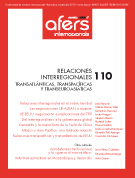Introducción: las relaciones interregionales en el orden mundial
Paraules clau:
relaciones interregionales, América del Norte, Europa, Asia, cadenas globales de valorResum
Revista CIDOB d’Afers Internacionals, nº 110
Cuatrimestral (mayo-septiembre 2015 )
ISSN:1133-6595 | E-ISSN:2013-035X
Este artículo reflexiona sobre los factores que han hecho que, desde finales del siglo pasado, el análisis de las relaciones interregionales sea fundamental para entender el orden geopolítico y geoeconómico mundial. Entendiendo las relaciones interregionales como aquellas que se establecen entre dos grupos regionales, entre un Estado y una región o incluso en el seno de una megarregión, este texto asocia la creciente importancia de este tipo de relaciones a diversas causas: el crecimiento de la demanda en las economías emergentes y las interacciones entre ellas; un nuevo marco de relaciones económicas interregionales, y la aparición de nuevas vías comerciales. Asimismo, el artículo introduce los trabajos que se incluyen en este monográfico.
Referències
Baldwin, Richard. «Trade and Industrialization after Globalization’s Second Unbundling: How Building and Joining a Supply Chain Are Different and Why it Matters», en: Feenstra,Robert C. y Taylor, Alan M. (eds.) Globalization in an Age of Crisis: Multilateral Economic Cooperation in the Twenty-First Century. University of Chicago Press, 2014, p. 165-212. (en línea) [Fecha de consulta: mayo 2015] http://www.nber.org/chapters/c12590
Bernhofen, Daniel; El-Sahli, Zouheir; Kneller, Richard. «Estimating the Effects of the Container Revolution on World Trade». Working Paper (febrero de 2013). Lund University(en línea) [Fecha de consulta: mayo 2015] http://www.lunduniversity.lu.se/lup/publication/3469484
Blyde, Juan (coord.) Fábricas sincronizadas. América Latina y el Caribe en la Era de las Cadenas Globales de Valor.Banco Interamericano de Desarrollo, 2014.
De Backer, Koen y Miroudot, Sébastien. «Mapping Global Value Chains». OECD TradePolicyPapers, n.º 159 (19 de diciembre de 2013) (en línea) [Fecha de consulta: junio de 2014] http://dx.doi.org/10.1787/5k3v1trgnbr4-en
Feenstra, Robert C. «Integration of trade and disintegration of production in the global economy». Journal of Economic Perspectives, n.º 12 (1998), p. 31-50.
Feenstra, Robert y Taylor, Alan M. International Trade. New York y Basingstoke W. H. Freeman and Co., 2008.(Versión en español: Editorial Reverté, 2011).
Hänggi, Heiner; Roloff, Ralf y Rüland, Jurgen (eds.). Interregionalism and International Relations. Londres: Routledge, 2005.
Nye, Joseph S. y Keohane, Robert O. «Transnational Relations and World Politics: An Introduction». International Organization, n.º 25 (1971), p. 329-349.
OCDE. Interconnected economies: Benefiting from Global Value Chains. OCDE publishing, 2013.
OCDE-WTO-UNCTAD. «Report to G-20 on Implications of Global Value Chains for Trade, Investment, Development and Jobs». Preparado para la cumbre de líderes del G-20 en San Petersburgo (Federación Rusa), septiembre de 2013. (en línea) [Fecha de consulta: junio de 2014] http://www.oecd.org/trade/G20-Global-Value-Chains-2013.pdf
The Economist. «The Humble Hero». The Economist (18 de mayo de 2013) (en línea) http://www.economist.com/news/finance-and-economics/21578041-containers-have-been-more-important-globalisation-freer-trade-humble
Ventura-Dias, Vivianne. «What Can We Say About Trade and Growth When Trade Becomes a Complex System?».Serie Comercio Internacional, n.º 27 (2003). ECLAC: Santiago de Chile.












